SKODA CITIGO 2012 1.G Workshop Manual
Manufacturer: SKODA, Model Year: 2012, Model line: CITIGO, Model: SKODA CITIGO 2012 1.GPages: 157, PDF Size: 3.9 MB
Page 51 of 157

Stowage compartment in front centre console
Fig. 54
Front centre console: Stowage
compartment
The open stowage compartment in the centre console » Fig. 54. ÐMultimedia holder
Fig. 55
Front centre console: Multimedia
holder
The multimedia holder can be found in the stowage compartment of the front
centre console ┬╗ Fig. 55.
You can use this holder to store e.g. a mobile phone, MP3 player or similar devi-
ces. WARNING
Never use the multimedia holder as an ashtray or for storing flammable ob-
jects ŌĆō risk of fire! ├É Meshed pockets at the front seat rests
Fig. 56
Front seat rests: Meshed pockets
The insides of the front seat rests have meshed pockets ┬╗ Fig. 56.
These meshed pockets are designed for small, light objects, such as a mobile
phone or MP3 player. WARNING
You can use the meshed pockets to store items with a gross weight of up to
150 g. Heavy objects are not secured sufficiently - risk of injury! CAUTION
Never put large objects into the meshed pocket, e.g. bottles or objects with sharp
edges - risk of damaging the meshed pocket. Ð Stowage compartments in front of the rear seats
Fig. 57
In front of the rear seats: Stow-
age compartment ┬Ż
49
Seats and Stowage
Page 52 of 157
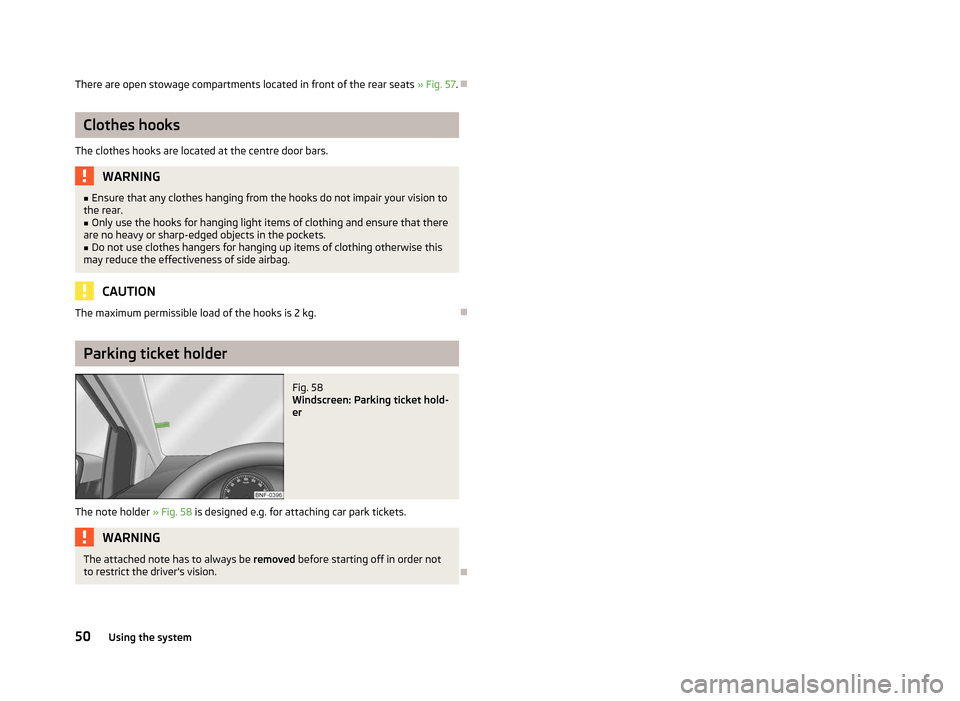
There are open stowage compartments located in front of the rear seats
» Fig. 57.ÐClothes hooks
The clothes hooks are located at the centre door bars. WARNING
Ō¢Ā Ensure that any clothes hanging from the hooks do not impair your vision to
the rear.
Ō¢Ā Only use the hooks for hanging light items of clothing and ensure that there
are no heavy or sharp-edged objects in the pockets.
Ō¢Ā Do not use clothes hangers for hanging up items of clothing otherwise this
may reduce the effectiveness of side airbag. CAUTION
The maximum permissible load of the hooks is 2 kg. ÐParking ticket holder
Fig. 58
Windscreen: Parking ticket hold-
er
The note holder ┬╗ Fig. 58 is designed e.g. for attaching car park tickets.WARNING
The attached note has to always be removed before starting off in order not
to restrict the driver's vision. Ð50
Using the system
Page 53 of 157
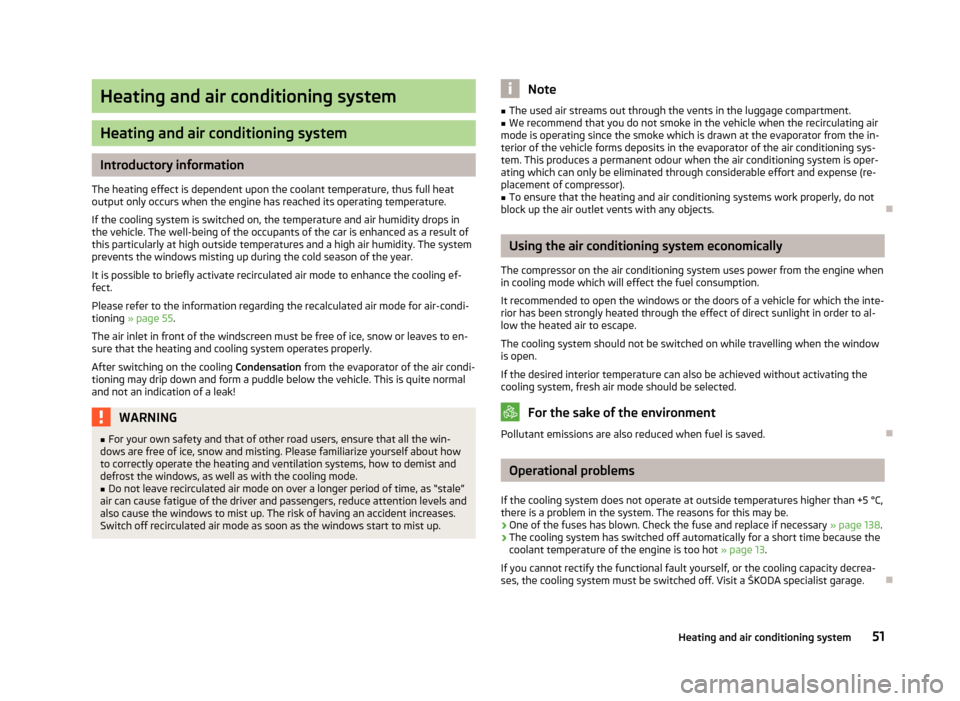
Heating and air conditioning system
Heating and air conditioning system
Introductory information
The heating effect is dependent upon the coolant temperature, thus full heat
output only occurs when the engine has reached its operating temperature.
If the cooling system is switched on, the temperature and air humidity drops in
the vehicle. The well-being of the occupants of the car is enhanced as a result of
this particularly at high outside temperatures and a high air humidity. The system
prevents the windows misting up during the cold season of the year.
It is possible to briefly activate recirculated air mode to enhance the cooling ef-
fect.
Please refer to the information regarding the recalculated air mode for air-condi-
tioning ┬╗ page 55.
The air inlet in front of the windscreen must be free of ice, snow or leaves to en-
sure that the heating and cooling system operates properly.
After switching on the cooling Condensation from the evaporator of the air condi-
tioning may drip down and form a puddle below the vehicle. This is quite normal
and not an indication of a leak! WARNING
Ō¢Ā For your own safety and that of other road users, ensure that all the win-
dows are free of ice, snow and misting. Please familiarize yourself about how
to correctly operate the heating and ventilation systems, how to demist and
defrost the windows, as well as with the cooling mode.
Ō¢Ā Do not leave recirculated air mode on over a longer period of time, as ŌĆ£staleŌĆØ
air can cause fatigue of the driver and passengers, reduce attention levels and
also cause the windows to mist up. The risk of having an accident increases.
Switch off recirculated air mode as soon as the windows start to mist up. Note
Ō¢Ā The used air streams out through the vents in the luggage compartment.
Ō¢Ā We recommend that you do not smoke in the vehicle when the recirculating air
mode is operating since the smoke which is drawn at the evaporator from the in-
terior of the vehicle forms deposits in the evaporator of the air conditioning sys-
tem. This produces a permanent odour when the air conditioning system is oper-
ating which can only be eliminated through considerable effort and expense (re-
placement of compressor).
Ō¢Ā To ensure that the heating and air conditioning systems work properly, do not
block up the air outlet vents with any objects. Ð Using the air conditioning system economically
The compressor on the air conditioning system uses power from the engine when
in cooling mode which will effect the fuel consumption.
It recommended to open the windows or the doors of a vehicle for which the inte-
rior has been strongly heated through the effect of direct sunlight in order to al-
low the heated air to escape.
The cooling system should not be switched on while travelling when the window
is open.
If the desired interior temperature can also be achieved without activating the
cooling system, fresh air mode should be selected. For the sake of the environment
Pollutant emissions are also reduced when fuel is saved. Ð Operational problems
If the cooling system does not operate at outside temperatures higher than +5 ┬░C,
there is a problem in the system. The reasons for this may be.
ŌĆ║ One of the fuses has blown. Check the fuse and replace if necessary
┬╗
page 138.
ŌĆ║ The cooling system has switched off automatically for a short time because the
coolant temperature of the engine is too hot ┬╗ page 13.
If you cannot rectify the functional fault yourself, or the cooling capacity decrea-
ses, the cooling system must be switched off. Visit a ┼ĀKODA specialist garage. ├É
51
Heating and air conditioning system
Page 54 of 157
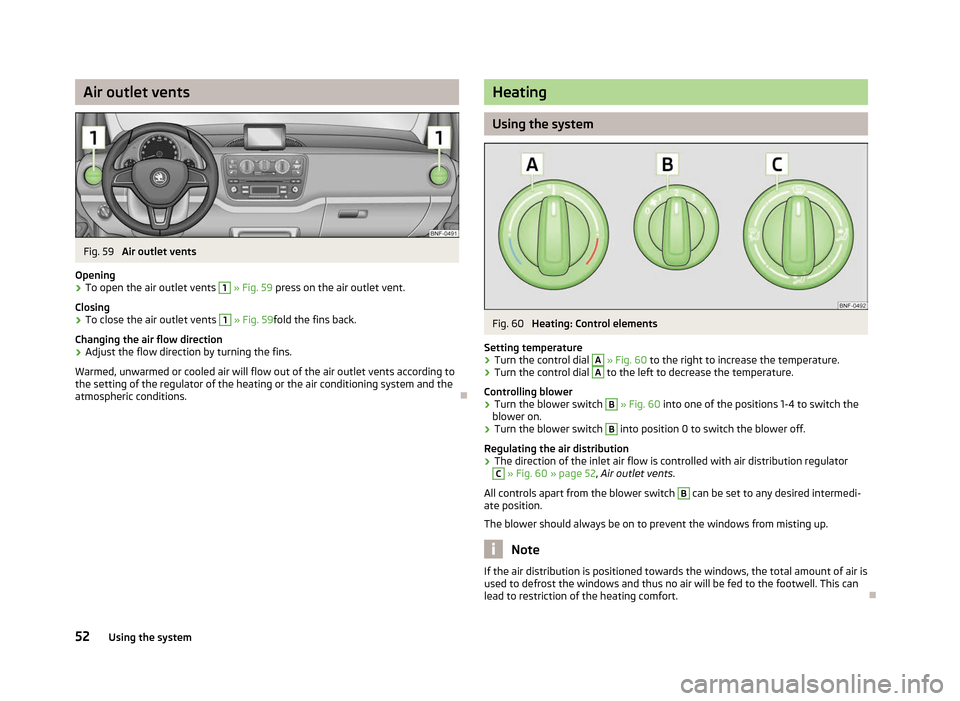
Air outlet vents
Fig. 59
Air outlet vents
Opening
ŌĆ║ To open the air outlet vents 1
┬╗ Fig. 59 press on the air outlet vent.
Closing
ŌĆ║ To close the air outlet vents 1
┬╗ Fig. 59
fold the fins back.
Changing the air flow direction
ŌĆ║ Adjust the flow direction by turning the fins.
Warmed, unwarmed or cooled air will flow out of the air outlet vents according to
the setting of the regulator of the heating or the air conditioning system and the
atmospheric conditions. Ð Heating
Using the system
Fig. 60
Heating: Control elements
Setting temperature ŌĆ║ Turn the control dial A
┬╗ Fig. 60 to the right to increase the temperature.
ŌĆ║ Turn the control dial A
to the left to decrease the temperature.
Controlling blower
ŌĆ║ Turn the blower switch B
┬╗ Fig. 60 into one of the positions 1-4 to switch the
blower on.
ŌĆ║ Turn the blower switch B
into position 0 to switch the blower off.
Regulating the air distribution
ŌĆ║ The direction of the inlet air flow is controlled with air distribution regulator C
┬╗ Fig. 60
┬╗ page 52, Air outlet vents.
All controls apart from the blower switch B
can be set to any desired intermedi-
ate position.
The blower should always be on to prevent the windows from misting up. Note
If the air distribution is positioned towards the windows, the total amount of air is
used to defrost the windows and thus no air will be fed to the footwell. This can
lead to restriction of the heating comfort. Ð
52 Using the system
Page 55 of 157

Setting heating
Recommended basic settings of the heating controls for the respective operating
modes:
Set-up Setting of the control dial
Air outlet vents 1
A B C
Defrosting the windscreen and side windows To the right up to the stop
3
’ü£Open and align with the side window
Free windscreen and side windows from mist Desired temperature 2 or 3
’ü£ ’āł ’éĘOpen and align with the side window
The fastest heating To the right up to the stop3
’éĘ Opening
Comfortable heating Desired temperature2 or 3
’éĘ ’āł ’ü▒ Opening
Fresh air mode ŌĆō ventilation To the left up to the stop Desired position
’ü▒OpeningNote
Ō¢Ā Control elements A
, B
, C
┬╗ Fig. 60
on page 52.
Ō¢Ā Air outlet vents 1
┬╗ Fig. 59
on page 52. ÐAir conditioning system
Introductory information
The cooling system only operates if the button AC E
┬╗ Fig. 61 on page 54 is
pressed, and the following conditions are met:
ŌĆ║ engine running;
ŌĆ║ outside temperature above approx. +2 ┬░C;
ŌĆ║ blower switch switched on (positions 1-4). Under certain circumstances, air at a temperature of about 5 ┬░C can flow out of
the vents when the cooling system is switched on. Lengthy and uneven distribu-
tion of the air flow out of the vents and large differences in temperature between
inside and outside, for example when getting out of the vehicle, can result in
chills in sensitive persons. Note
We recommend that you have the air conditioning system cleaned by a ┼ĀKODA
specialist garage once every year. Ð
53
Heating and air conditioning system
Page 56 of 157
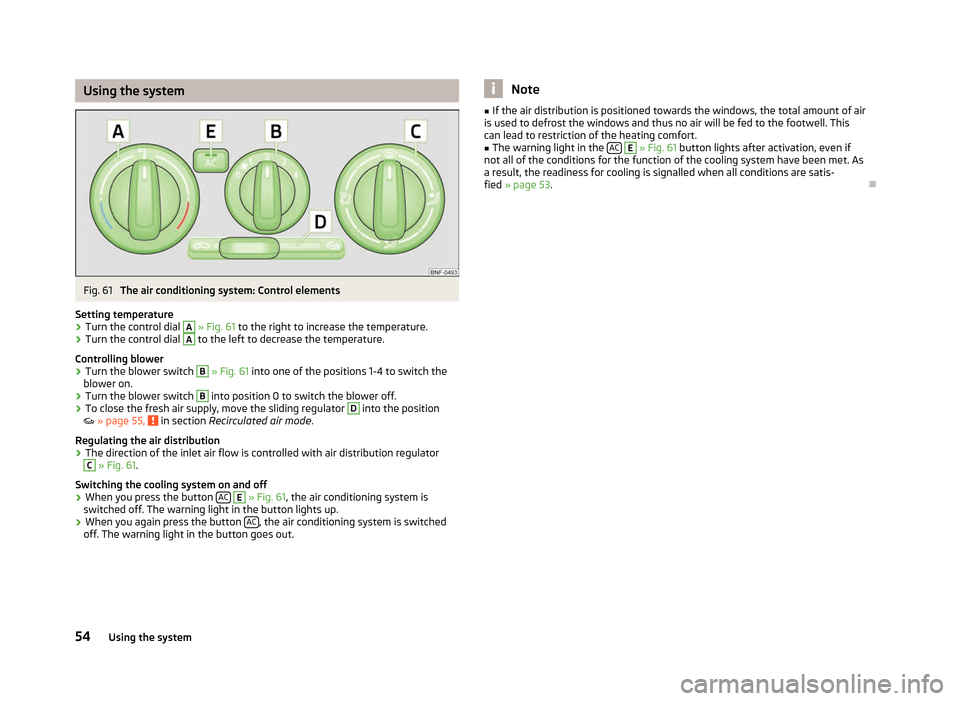
Using the system
Fig. 61
The air conditioning system: Control elements
Setting temperature
ŌĆ║ Turn the control dial A
┬╗ Fig. 61 to the right to increase the temperature.
ŌĆ║ Turn the control dial A
to the left to decrease the temperature.
Controlling blower
ŌĆ║ Turn the blower switch B
┬╗ Fig. 61 into one of the positions 1-4 to switch the
blower on.
ŌĆ║ Turn the blower switch B
into position 0 to switch the blower off.
ŌĆ║ To close the fresh air supply, move the sliding regulator D
into the position
’Ć░ ┬╗
page 55, in section
Recirculated air mode .
Regulating the air distribution
ŌĆ║ The direction of the inlet air flow is controlled with air distribution regulator C
┬╗ Fig. 61.
Switching the cooling system on and off
ŌĆ║ When you press the button
AC E
┬╗ Fig. 61
, the air conditioning system is
switched off. The warning light in the button lights up.
ŌĆ║ When you again press the button
AC , the air conditioning system is switched
off. The warning light in the button goes out. Note
Ō¢Ā If the air distribution is positioned towards the windows, the total amount of air
is used to defrost the windows and thus no air will be fed to the footwell. This
can lead to restriction of the heating comfort. Ō¢Ā The warning light in the AC E
┬╗ Fig. 61 button lights after activation, even if
not all of the conditions for the function of the cooling system have been met. As
a result, the readiness for cooling is signalled when all conditions are satis-
fied » page 53. Ð54
Using the system
Page 57 of 157
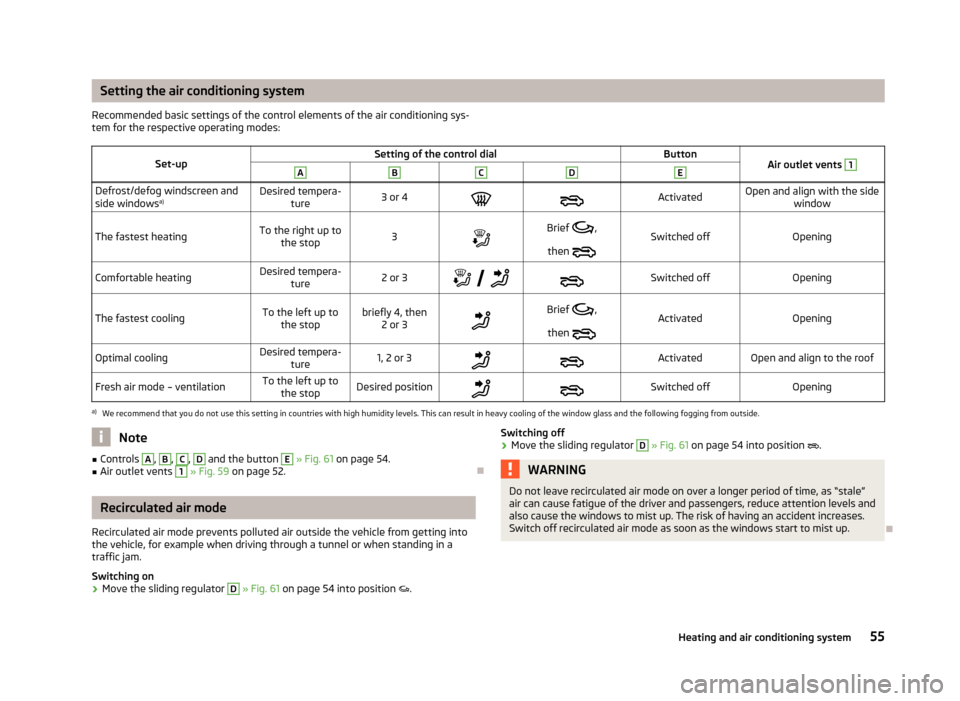
Setting the air conditioning system
Recommended basic settings of the control elements of the air conditioning sys-
tem for the respective operating modes:
Set-up Setting of the control dial
Button
Air outlet vents 1
A B C D E
Defrost/defog windscreen and
side windows
a) Desired tempera-
ture 3 or 4
’ü£ ’Ć¼ ActivatedOpen and align with the side
window
The fastest heating To the right up to
the stop 3
’éĘBrief
’Ć░,
then ’Ć¼ Switched off
Opening
Comfortable heating Desired tempera-
ture 2 or 3
’éĘ ’āł ’ü▒ ’Ć¼Switched off
Opening
The fastest cooling To the left up to
the stop briefly 4, then
2 or 3 ’ü▒Brief
’Ć░,
then ’Ć¼ Activated
Opening
Optimal cooling Desired tempera-
ture 1, 2 or 3
’ü▒ ’Ć¼ Activated Open and align to the roof
Fresh air mode ŌĆō ventilation To the left up to
the stop Desired position
’ü▒ ’Ć¼ Switched off
Openinga)
We recommend that you do not use this setting in countries with high humidity levels. This can result in heavy cooling of the window glass and the following fogging from outside. Note
Ō¢Ā Controls A
, B
, C
, D
and the button E
┬╗ Fig. 61 on page 54.
Ō¢Ā Air outlet vents 1
┬╗ Fig. 59
on page 52. ÐRecirculated air mode
Recirculated air mode prevents polluted air outside the vehicle from getting into
the vehicle, for example when driving through a tunnel or when standing in a
traffic jam.
Switching on
ŌĆ║ Move the sliding regulator D
┬╗ Fig. 61
on page 54 into position ’Ć░. Switching off
ŌĆ║
Move the sliding regulator D
┬╗
Fig. 61
on page 54 into position ’Ć¼. WARNING
Do not leave recirculated air mode on over a longer period of time, as ŌĆ£staleŌĆØ
air can cause fatigue of the driver and passengers, reduce attention levels and
also cause the windows to mist up. The risk of having an accident increases.
Switch off recirculated air mode as soon as the windows start to mist up. Ð 55
Heating and air conditioning system
Page 58 of 157
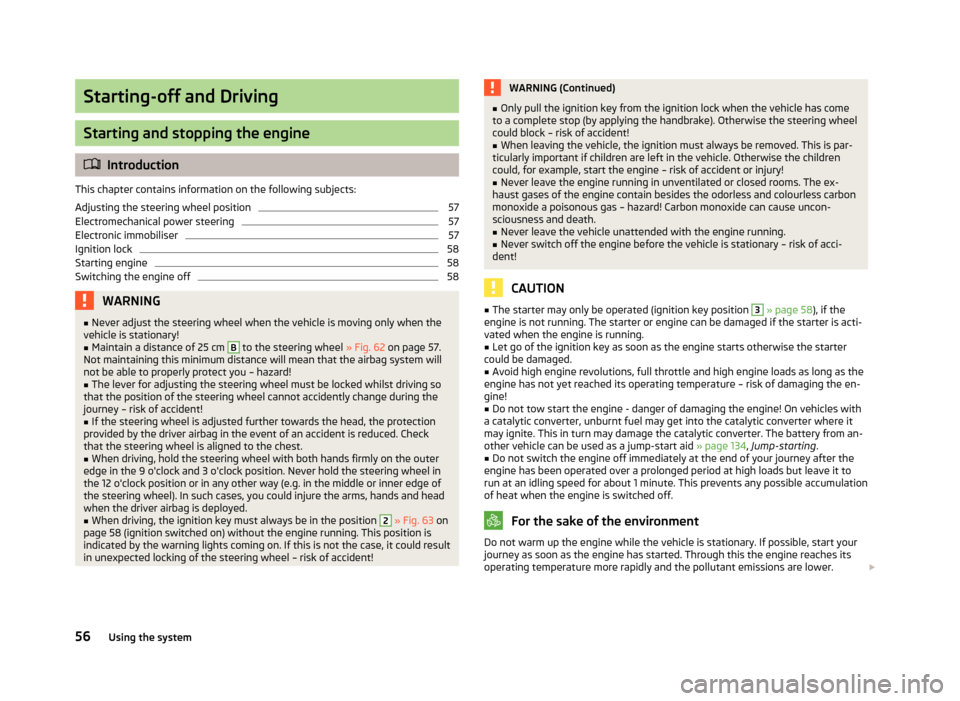
Starting-off and Driving
Starting and stopping the engine
├ż
Introduction
This chapter contains information on the following subjects:
Adjusting the steering wheel position 57
Electromechanical power steering 57
Electronic immobiliser 57
Ignition lock 58
Starting engine 58
Switching the engine off 58
WARNING
Ō¢Ā Never adjust the steering wheel when the vehicle is moving only when the
vehicle is stationary!
Ō¢Ā Maintain a distance of 25 cm B
to the steering wheel
┬╗ Fig. 62 on page 57.
Not maintaining this minimum distance will mean that the airbag system will
not be able to properly protect you ŌĆō hazard! Ō¢Ā The lever for adjusting the steering wheel must be locked whilst driving so
that the position of the steering wheel cannot accidently change during the
journey ŌĆō risk of accident! Ō¢Ā If the steering wheel is adjusted further towards the head, the protection
provided by the driver airbag in the event of an accident is reduced. Check
that the steering wheel is aligned to the chest. Ō¢Ā When driving, hold the steering wheel with both hands firmly on the outer
edge in the 9
o'clock and 3 o'clock position. Never hold the steering wheel in
the 12 o'clock position or in any other way (e.g. in the middle or inner edge of
the steering wheel). In such cases, you could injure the arms, hands and head
when the driver airbag is deployed. Ō¢Ā When driving, the ignition key must always be in the position 2
┬╗ Fig. 63 on
page 58
(ignition switched on) without the engine running. This position is
indicated by the warning lights coming on. If this is not the case, it could result
in unexpected locking of the steering wheel ŌĆō risk of accident! WARNING (Continued)
Ō¢Ā Only pull the ignition key from the ignition lock when the vehicle has come
to a complete stop (by applying the handbrake). Otherwise the steering wheel
could block ŌĆō risk of accident!
Ō¢Ā When leaving the vehicle, the ignition must always be removed. This is par-
ticularly important if children are left in the vehicle. Otherwise the children
could, for example, start the engine ŌĆō risk of accident or injury!
Ō¢Ā Never leave the engine running in unventilated or closed rooms. The ex-
haust gases of the engine contain besides the odorless and colourless carbon
monoxide a poisonous gas ŌĆō hazard! Carbon monoxide can cause uncon-
sciousness and death. Ō¢Ā Never leave the vehicle unattended with the engine running.
Ō¢Ā Never switch off the engine before the vehicle is stationary ŌĆō risk of acci-
dent! CAUTION
Ō¢Ā The starter may only be operated (ignition key position 3
┬╗ page 58), if the
engine is not running. The starter or engine can be damaged if the starter is acti-
vated when the engine is running. Ō¢Ā Let go of the ignition key as soon as the engine starts otherwise the starter
could be damaged. Ō¢Ā Avoid high engine revolutions, full throttle and high engine loads as long as the
engine has not yet reached its operating temperature ŌĆō risk of damaging the en-
gine!
Ō¢Ā Do not tow start the engine - danger of damaging the engine! On vehicles with
a catalytic converter, unburnt fuel may get into the catalytic converter where it
may ignite. This in turn may damage the catalytic converter. The battery from an-
other vehicle can be used as a jump-start aid ┬╗ page 134, Jump-starting .
Ō¢Ā Do not switch the engine off immediately at the end of your journey after the
engine has been operated over a prolonged period at high loads but leave it to
run at an idling speed for about 1
minute. This prevents any possible accumulation
of heat when the engine is switched off. For the sake of the environment
Do not warm up the engine while the vehicle is stationary. If possible, start your
journey as soon as the engine has started. Through this the engine reaches its
operating temperature more rapidly and the pollutant emissions are lower. ┬Ż
56 Using the system
Page 59 of 157
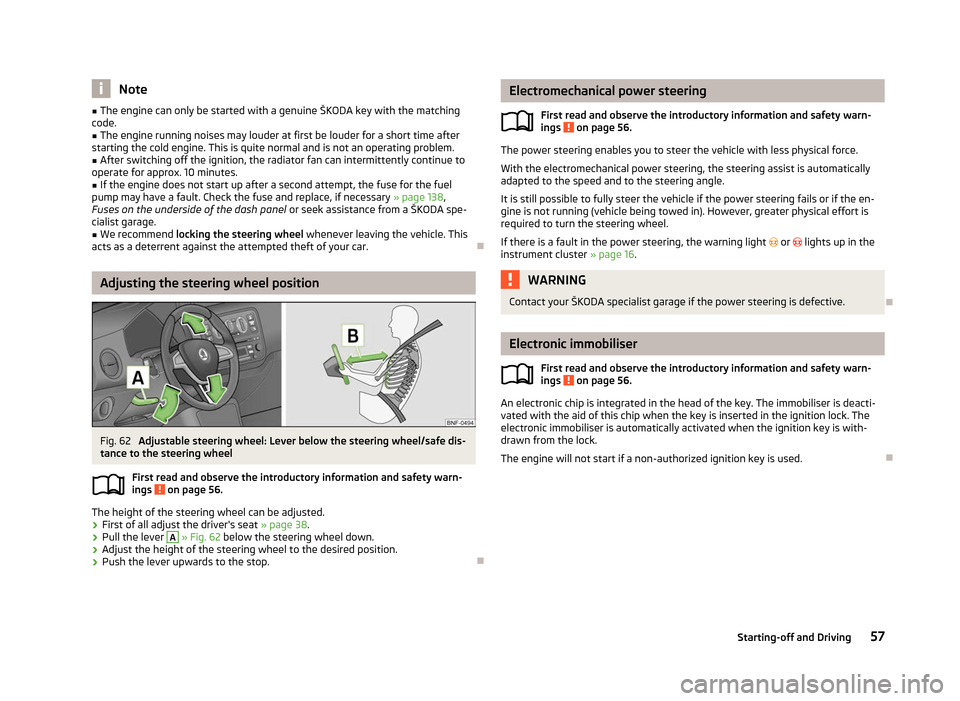
Note
Ō¢Ā The engine can only be started with a genuine ┼ĀKODA key with the matching
code. Ō¢Ā The engine running noises may louder at first be louder for a short time after
starting the cold engine. This is quite normal and is not an operating problem. Ō¢Ā After switching off the ignition, the radiator fan can intermittently continue to
operate for approx. 10
minutes.
Ō¢Ā If the engine does not start up after a second attempt, the fuse for the fuel
pump may have a fault. Check the fuse and replace, if necessary ┬╗ page 138,
Fuses on the underside of the dash panel or seek assistance from a ┼ĀKODA
spe-
cialist garage.
Ō¢Ā We recommend locking the steering wheel whenever leaving the vehicle. This
acts as a deterrent against the attempted theft of your car. ÐAdjusting the steering wheel position
Fig. 62
Adjustable steering wheel: Lever below the steering wheel/safe dis-
tance to the steering wheel
First read and observe the introductory information and safety warn-
ings on page 56.
The height of the steering wheel can be adjusted.
ŌĆ║ First of all adjust the driver's seat
┬╗ page 38.
ŌĆ║ Pull the lever A
┬╗ Fig. 62 below the steering wheel down.
ŌĆ║ Adjust the height of the steering wheel to the desired position.
ŌĆ║ Push the lever upwards to the stop. ├É
├ż Electromechanical power steering
First read and observe the introductory information and safety warn-
ings on page 56.
The power steering enables you to steer the vehicle with less physical force.
With the electromechanical power steering, the steering assist is automatically
adapted to the speed and to the steering angle.
It is still possible to fully steer the vehicle if the power steering fails or if the en-
gine is not running (vehicle being towed in). However, greater physical effort is
required to turn the steering wheel.
If there is a fault in the power steering, the warning light ’üŻ or ’üŻ lights up in the
instrument cluster ┬╗ page 16. WARNING
Contact your ┼ĀKODA specialist garage if the power steering is defective. ├É Electronic immobiliser
First read and observe the introductory information and safety warn-
ings on page 56.
An electronic chip is integrated in the head of the key. The immobiliser is deacti-
vated with the aid of this chip when the key is inserted in the ignition lock. The
electronic immobiliser is automatically activated when the ignition key is with-
drawn from the lock.
The engine will not start if a non-authorized ignition key is used. Ð
├ż
├ż
57
Starting-off and Driving
Page 60 of 157
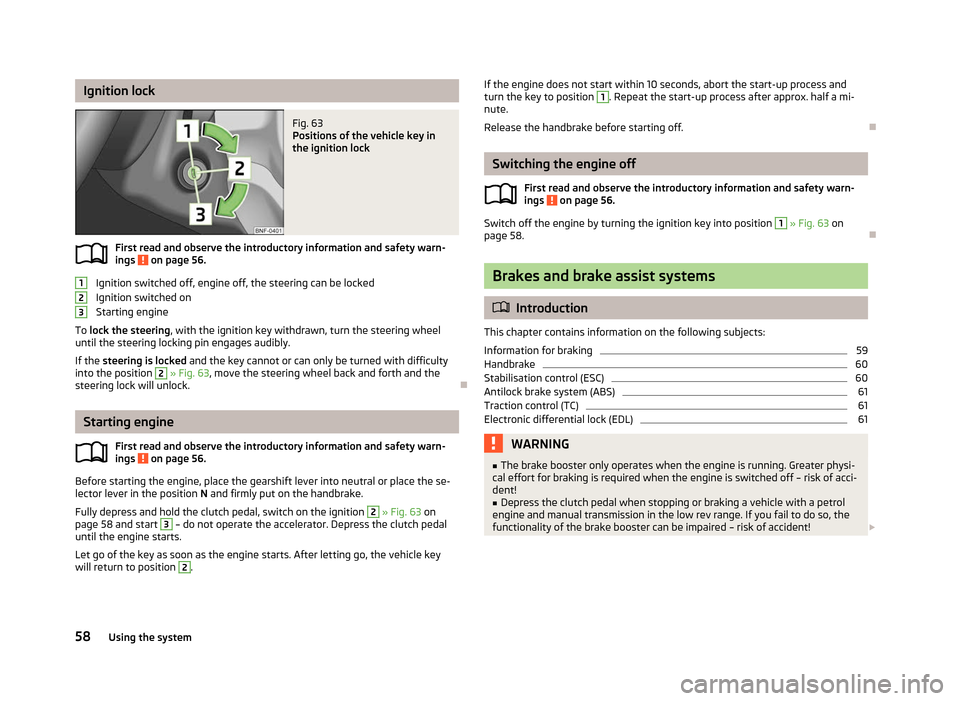
Ignition lock
Fig. 63
Positions of the vehicle key in
the ignition lock
First read and observe the introductory information and safety warn-
ings on page 56.
Ignition switched off, engine off, the steering can be locked
Ignition switched on
Starting engine
To lock the steering , with the ignition key withdrawn, turn the steering wheel
until the steering locking pin engages audibly.
If the steering is locked and the key cannot or can only be turned with difficulty
into the position 2
┬╗ Fig. 63, move the steering wheel back and forth and the
steering lock will unlock. ÐStarting engine
First read and observe the introductory information and safety warn-
ings on page 56.
Before starting the engine, place the gearshift lever into neutral or place the se-
lector lever in the position N and firmly put on the handbrake.
Fully depress and hold the clutch pedal, switch on the ignition 2
┬╗ Fig. 63 on
page 58
and start 3
ŌĆō do not operate the accelerator. Depress the clutch pedal
until the engine starts.
Let go of the key as soon as the engine starts. After letting go, the vehicle key
will return to position 2
.
├ż 1
2
3
├ż If the engine does not start within 10 seconds, abort the start-up process and
turn the key to position 1
. Repeat the start-up process after approx. half a mi-
nute.
Release the handbrake before starting off. Ð Switching the engine off
First read and observe the introductory information and safety warn-
ings on page 56.
Switch off the engine by turning the ignition key into position 1
┬╗ Fig. 63 on
page 58
. Ð Brakes and brake assist systems
├ż
Introduction
This chapter contains information on the following subjects:
Information for braking 59
Handbrake 60
Stabilisation control (ESC) 60
Antilock brake system (ABS) 61
Traction control (TC) 61
Electronic differential lock (EDL) 61
WARNING
Ō¢Ā The brake booster only operates when the engine is running. Greater physi-
cal effort for braking is required when the engine is switched off ŌĆō risk of acci-
dent!
Ō¢Ā Depress the clutch pedal when stopping or braking a vehicle with a petrol
engine and manual transmission in the low rev range. If you fail to do so, the
functionality of the brake booster can be impaired ŌĆō risk of accident! ┬Ż
├ż
58 Using the system